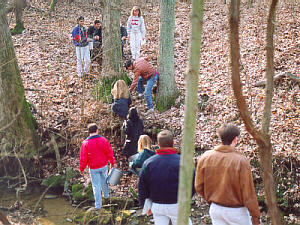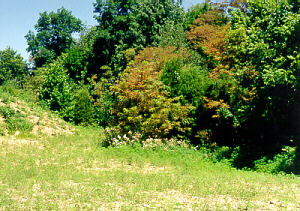Stratification and Ecotones
Vertical Distribution Patterns
There is vertical
stratification
in any ecological community. An ecosystem can be subdivided by the layers of
its vegetation. Stratification is determined especially by the sizes and
kinds of plants present.
A forest community typically includes a canopy, an understory
layer, shrubs, an herb/ground layer, and the forest floor, including roots
and soil.
- The canopy is the primary site of energy fixation. It influences
the amount of sunlight that penetrates deeper into the forest.
- The understory typically includes tall shrubs and smaller trees.
These must be shade-tolerant since they’re growing under the canopy trees.
- The shrub layer varies depending on the kind of and location of
the forest. For example, there may be differences in the shrub layer of
north- vs south-facing slopes within the same forest.
- The types of plants in the herb layer vary depending on the soil
humidity and the deepness of shade in an ecosystem.
- The forest floor is mainly a site of decomposition. Fallen
leaves and dead plants and animals are returned to the soil.
 Old, mature forests with well-filled-in canopies are frequently very open
underneath, and contain few shrubs and understory plants.
Old, mature forests with well-filled-in canopies are frequently very open
underneath, and contain few shrubs and understory plants.
Stratification also occurs in large bodies of water such as
lakes and oceans. In these, the layers are distinguished by light
penetration, temperature, amount of dissolved oxygen, etc.
- The
epilimnion
is the surface water. Light penetrates throughout the epilimnion, so
photosynthesis occurs. The epilimnion may be further subdivided into
- The
littoral zone,
where the water is shallow and light penetrates to the bottom/floor:
this zone is characterized by rooted plants which may include
emergent vegetation and some floating plants.
- The limnetic zone, which is open water with photosynthetic
phytoplankton distributed throughout: also common in this area are
nekton, organisms such as fish and invertebrates which move
freely despite any currents which may be present.
- The compensation level is the depth where light is so low that
not much photosynthesis occurs. At this level, cellular respiration and
photosynthesis balance each other, while above this level, there is more
photosynthesis, and below this level, there is more respiration and
decomposition.
- The profundal zone is the area beyond the depth of light
penetration. Organisms here depend on settling organic material from
above as their source of nutrients and energy. This zone may be divide
into:
- The
metalimnion,
which has a thermocline (a rapid decrease in temperature as
depth increases): since no light penetrates this deep,
photosynthesis does not occur.
- The
hypolimnion,
which is a deep, cold layer: the water is dense and low in dissolved
oxygen, and since no light reaches to this depth, the prevalent
organisms are decomposers.
- The
benthic zone
benthic zone (benthos = the depths of the sea) is the bottom
mud/ooze and contains mostly decomposers, collectively referred to as the
benthos. Due to their biological activity, little oxygen is
present, and most respiration is, therefore, anaerobic.
Horizontal Distribution Patterns
Local areas usually include a variety of communities such as
lawns, farmlands, old fields, shrubby areas (brambles and sumac), various
woodland with or without undergrowth, etc. The distributions of these
communities are tied in with the idea of succession. These distribution
patterns are also tied in with the ideas of edge and ecotone.
An edge is an area where two (or more) communities meet abruptly.
This may result from an abrupt change in soil type or other natural causes
(inherent) or as a result of human activities or fire (induced). An
ecotone is an area where two (or more) communities meet and
intergrade.

An edge

An ecotone

Garlic Mustard

Robin
Plants are competitive and will grow from the edge as far into each of the
communities as each species is able. Some highly-adaptable or
opportunistic species (white snakeroot, garlic mustard) can grow in
both communities. Some animals must live in an edge/ecotone community.
For example, an American Robin nests in trees but forages for food (pulls up
worms) in grassy field areas. Edge or ecotone areas generally have a greater
variety and density of life than other habitats. Typically, they have
species from both of the two adjoining habitats plus a number of specifically
edge species. This is known as the edge effect and the greater the
contrast between the two communities involved, the richer the species
diversity in the edge community.
Copyright © 1999 by J. Stein Carter. All rights reserved.
This page has been accessed  times since 1 Apr 2001.
times since 1 Apr 2001.
 Old, mature forests with well-filled-in canopies are frequently very open
underneath, and contain few shrubs and understory plants.
Old, mature forests with well-filled-in canopies are frequently very open
underneath, and contain few shrubs and understory plants.
 Old, mature forests with well-filled-in canopies are frequently very open
underneath, and contain few shrubs and understory plants.
Old, mature forests with well-filled-in canopies are frequently very open
underneath, and contain few shrubs and understory plants.



